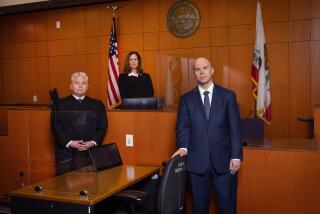Making Bail
I am writing to take issue with the (May 3) article “Federal Courts in San Diego Tough on Bail” by Alan Abrahamson, which presents a misleading picture of the bail practices in this district by selectively presenting only some of the statistics.
The article claims it is harder to get out on bail in this district than any other district in the country, but relies exclusively on statistics about defendants who do not make monetary bail at their first court appearance. The story then claims that these “statistics explain why the federal Metropolitan Correctional Center . . . is packed.”
If you are going to cite pretrial detention as a factor in jail crowding, you must look at both the percentage of defendants detained as well as the percentage released at their first hearing.
In San Diego district, 76% of the defendants were detained; 24% released. This compares to 59.4% detained in the Los Angeles district, which released 40.6%; and 82.6% detained in the Sacramento district, which released 17.4% of its defendants. In El Paso, 80.7% were detained; in Houston, 77.3%; in Miami, 71.4%.
To further put these figures in perspective, you should consider that 64.4% of our district’s indictments are drug-related compared to a national average of 42.4%. Congress, by statute, has specifically identified those charged with narcotics offenses as greater flight risks or posing a danger to the community.
Another factor in determining bail is the defendant’s willingness to be interviewed before trial. More than 30% of our defendants refused to be interviewed, compared to the national average of 5.9%. Without the benefit of this interview, how can the courts be expected to make an intelligent decision?
When you consider these statistics, it is clear that the San Diego district is not “wildly out of line with every other federal court.” Instead, we have conscientious district judges and magistrate judges who do their best to make individualized judgments. They have been done a disservice by your article, which seeks to sensationalize by selectively presenting only a narrow range of the statistics and then distorting their significance.
The article further distorts by giving the impression that my only comment to Mr. Abrahamson was limited to denying that bail was used to extort guilty pleas. In fact, I spoke to him for 22 minutes before the article was published, and told him that to present a true picture he had to look at both defendants held in lieu of monetary bail and those held without bail.
WILLIAM BRANIFF, U.S. Attorney, San Diego
More to Read
Sign up for Essential California
The most important California stories and recommendations in your inbox every morning.
You may occasionally receive promotional content from the Los Angeles Times.









